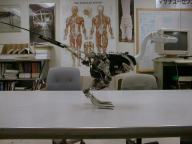Troody Fully Contained 3D Bipedal Walking Dinosaur Robot |
M2
 3D Bipedal Walker |
Walkers | Runners/Hoppers | Miscellaneous
| We have built a series of legged robots for
experiments on active balance in dynamic legged locomotion. Taken collectively, these robots have traversed simple paths, run with several different gaits (hop, run, trot, pace, bound), run fast (13 mph), jumped over obstacles, controlled step length, climbed a simplified stairway, walked over ramps, and performed rudimentary gymnastic maneuvers. Although no one robot performed all these tasks, the machines all use a common set of balance and control principles. |
Robots In Progress
|
|
Walking Robots | Runners/Hoppers | Miscellaneous
|
|
|
Walkers | Running & Hopping Robots | Miscellaneous
|
|
|
|||
|
|
|
|||
|
|
|
Walkers | Runners/Hoppers | Miscellaneous Robots
|
|
|
| Information | Robots | Simulations | Publications | People |
© Copyright MIT Leg Laboratory. All Rights Reserved.